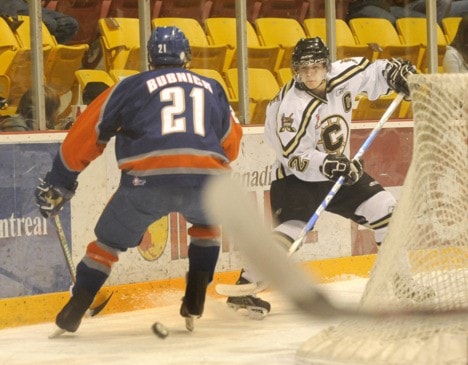They’ve always thought of Jesse Craige as a power play specialist. Everyone who’s ever watched him play has looked at his diminutive five-foot-10 and 160 pound frame and assumed he must be an offence-first guy.
The smooth-skating blueliner has always balked at the notion that small automatically equals one-dimensional. He has always worked hard to be the best defenceman he can be, on the power play and five-on-five.
But this year, the numbers are betraying the Edmonton native. It’s hard to dispute the notion that you’re a power play specialist when 91 per cent of your points are accumulated with the man advantage.
Craige has seven goals this season, all of them scored on the power play. Thirty of his 33 points have come via special teams.
“People have labelled me as a power play guy since I was a 14-year-old bantam draft pick, maybe because I’m smaller,” Craige admitted. “I don’t know if that’s a good thing or a bad thing, to be honest. I always think I can do a better job contributing at even strength, but this year the points seem to be coming on the power play, and I should take them as they come.”
Craige shouldn’t under-sell himself too much, because excelling on the power play is not something everyone can do. Not everyone has the ability to carry the puck into the offensive zone to set up a power play. Not everyone can control play from the point, breaking down a penalty kill with smart passes and accurate shots.
“I was fortunate to come into the league on a team (Lethbridge) that gave me a lot of opportunities on the power play, even as a 16-year-old,” Craige said. “I also had the chance to learn from older guys. Brent Seabrook (now with the NHL’s Chicago Blackhawks) was there when I played a few games as a 15-year-old, and Colton Yellow Horn used to run the power play. I had a lot of guys to learn from and a lot of opportunities to succeed.”
From those wily veterans, the 20-year-old learned that power play quarterbacking requires a certain mind-set.
“Poise and deception and not panicking under pressure,” Craige elaborated. “It’s about looking off defenders, taking that extra second with the puck and scanning the ice to see the whole play. Also, a lot of power play work is talk, and the guys on our team do a great job of communicating out there.”
Last season, Chilliwack’s power play sputtered through 72 regular season games, operating at 13.5 per cent efficiency. The game plan was essentially to get the puck to Ryan Howse and hope for the best.
But as talent has been added and the pre-existing talent has developed, Craige has found his power play options growing. As a unit, Chilliwack’s power play entered last weekend ranked 14th in the Western Hockey League, operating at 19 per cent efficiency. When Craige looks to his right now, he sees Brandon Manning. The Chilliwack captain was a raw work-in-progress through his first season and a bit, but the Prince George native has locked in this season as one of the more threatening blueliners the WHL has to offer.
It certainly helps Craige that opponents have to respect Manning and his cannon of a slap-shot.
“It’s great to have him next to me, because when you have that big shot back there, the penalty killers have to respect it,” Craige confirmed. “Once Brandon takes a couple big shots, it gets them thinking and opens up the ice for me to set up back-door plays and things like that.”
Craige doesn’t possess the same rocket launcher shot that Manning has, but his point shot is surprisingly heavy and almost always on net.
The veteran had two goals in a 4-2 loss to the Vancouver Giants Feb. 13.
Neither shot would be classified as a ‘cannon,’ but both were hard, and more importantly, on net. There’s not much upside in launching rockets if no one knows where the puck is going.
“A lot of the credit on those two goals goes to Chris Collins, because he was standing in front of the net screening,” Craige explained. “Brandon and I have scored a lot of goals where you’d have to credit the forwards for getting in front, battling and having the bravery to put themselves in the path of those point shots.”
Howse still remains a potent option down low, as his team-leading 14 power play goals will attest.
But this year, he’s not alone. If the point shot is not there, Craige can look for the likes of Kevin Sundher (eight PP goals), Roman Horak, Jamie Crooks and Dylen McKinlay.
“A good power play has threats all over the ice and the ability to run plays from anywhere on the ice,” Craige said. “You can establish plays up high and down low, working off the half-wall. That gets the penalty killers running around, and that’s what we want. As soon as they start running all over the place, it opens up gaps where we can get pucks to the net and try to bang them home.”
As the Bruins finish off the stretch drive and head into the playoffs, Craige and company know that an effective power play will be a key to any success they have.
“At the very least, a power play has to gain momentum for a team, whether that’s through a goal or a couple shots or some some sustained pressure,” Craige said. “It can go one of two ways. It can work for you or it can take momentum away. When your power play is going, opponents get hesitant because they don’t want to take penalties and give you opportunities. It’s so huge.”
